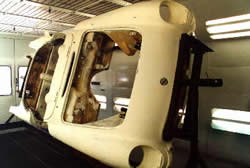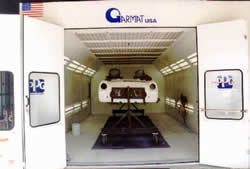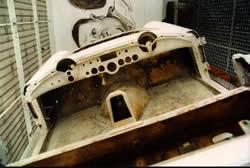1953 Corvette - No. 158 out of 300
Note: The following article and pictures first appeared on Doug Johnson's VetteOnline web site.
by Dennis Witt
 If you had two old 1953 Corvettes that could talk; if these cars had been 'rode hard and put away wet' in their prime; I'll bet they would say, "Yes, heaven for cars has to be defined as the care and treatment that is being bestowed on us in this afterlife's restoration."
If you had two old 1953 Corvettes that could talk; if these cars had been 'rode hard and put away wet' in their prime; I'll bet they would say, "Yes, heaven for cars has to be defined as the care and treatment that is being bestowed on us in this afterlife's restoration."
What are they talking about? They speak of the total restoration Classic Car Restoration and Service Center (CCRSC) in Tarpon Springs, Fl. is doing on them.
This restoration shop is a joint effort of Al Wiseman, Chris Brand and his brother, Jim Brand. Over the next six months, the restorative powers of the Brand brothers will be directed to these aging beauties.
Now, we do know that, like two former beauty queens, these '53s better days are certainly behind them. What would they pay to regain their voluptuous bodies and silky smooth skin?
Fortunately for our two 1953 Corvettes, the gods of youth have looked favorably on them and decided to spare them the ravages of old age as they have not been fed to the hungry jaws of a crusher and dumped into the landfill car hell.
The impetus behind the massive effort to restore these historically significant cars can be attributed to Carlisle Production co-owner Chip Miller and classic car collector Al Wiseman. Miller has been planning out his tribute to the Corvette's upcoming 50th birthday for the last five years. His dream was to restore a 1953 Corvette and display it around the country.
"I wanted a tribute to the upcoming 50th anniversary of the Corvette's birth in 1953," says Miller. "This golden anniversary of America's original sportscar isn't just for the car hobby - the Corvette has become a rolling statement of personal success and a cultural icon of 'cool' for America for almost half a century."
When Miller shared his idea with his friend Wiseman, he immediately agreed it was a great idea and proposed that they locate the necessary cars and get started on the restoration. Wiseman liked the idea so much he decided to build two 1953 Corvettes; one for the project, and one for his personal collection. The "Restoration Celebration" had begun.
The Corvette (car No.158), which is to be auctioned off at Corvettes during 'Carlisle in 2002' (with the proceeds going to charity) has jumped to the head of the line for the makeover process. This article will focus only on car No.158 as the other 1953 Corvette (No.147) is resting comfortably in storage waiting for its turn to be rejuvenated. Car No.147 will go to the personal collection of Wiseman.
 The frame of No. 158 has been straightened back to perfection, media blasted, hand-sanded and painted perfectly. All other components of the chassis received a similar refurbishing, and the engine and transmission have been reunited with their metal brethren once again. The last months have been spent on one of the most difficult parts of the restoration, restoring the fiberglass body to better than new condition.
The frame of No. 158 has been straightened back to perfection, media blasted, hand-sanded and painted perfectly. All other components of the chassis received a similar refurbishing, and the engine and transmission have been reunited with their metal brethren once again. The last months have been spent on one of the most difficult parts of the restoration, restoring the fiberglass body to better than new condition.
Wiseman and Miller chose one of the masters in the restoration industry when they selected Chris Brand for this project. Toiling for 10 years repairing fiberglass boat hulls, Brand has elevated his restoration skills to an art form. Boat hulls are exposed to extreme environmental conditions, with the combination of salt water and unrelenting sun quickly providing feedback on what type of fiberglass repair works or doesn't work. His years of experience have paid off for car No.158. Its body will be transformed into a flawless work of art when he is finished.
 "I went through a lot of different manufacturers and experimented with a wide variety of methods before I found the optimal combination of materials and procedures to bring fiberglass back to perfect condition," says Brand.
"I went through a lot of different manufacturers and experimented with a wide variety of methods before I found the optimal combination of materials and procedures to bring fiberglass back to perfect condition," says Brand.
The body of car No.158 had been cosmetically restored previously, but was still in need of extensive work to bring it up to the standards expected by Miller and Wiseman.
After evaluating the body, Brand decided that the only way to achieve perfection was to strip it down to bare fiberglass and build it up from there. This insured that at each stage along the way, the procedure could be monitored, and if any flaws were detected, they could be remedied immediately.
 Classic Car Restoration and Service Center is a brand new facility with state-of-the-art equipment capable of tackling the most complex restorations. "About the only thing we don't do in-house is chrome plating," Brand said. So off to the media blasting building went our soon-to-be-naked patient.Using plastic media hard enough to remove paint but not hard enough to damage the underlying fiberglass and gel coat, the body was completely stripped of its paint and primer, leaving only the bare fiberglass as laid down in 1953 in Flint, Mich. Since this car was to be perfect in every respect, the underside of the body was also stripped, even though 90 percent of this area will never be seen when the car is completed.
Classic Car Restoration and Service Center is a brand new facility with state-of-the-art equipment capable of tackling the most complex restorations. "About the only thing we don't do in-house is chrome plating," Brand said. So off to the media blasting building went our soon-to-be-naked patient.Using plastic media hard enough to remove paint but not hard enough to damage the underlying fiberglass and gel coat, the body was completely stripped of its paint and primer, leaving only the bare fiberglass as laid down in 1953 in Flint, Mich. Since this car was to be perfect in every respect, the underside of the body was also stripped, even though 90 percent of this area will never be seen when the car is completed.
But Brand insists that "the underside of the car will be restored to the same level as the exterior." In other words, at least double the amount of painstaking attention to detail will be lavished on this car.
 Once the car was stripped to bare fiberglass, the evaluation process began. All flaws were meticulously noted and a plan of action was developed to remedy them. Using all the knowledge and techniques accumulated over the years, Brand attacked the body and when he was finished, over 50 percent of it had been re-glassed. Hours upon hours were spent performing the tedious task of sanding the top and bottom of the car down to a glass smooth texture.
Once the car was stripped to bare fiberglass, the evaluation process began. All flaws were meticulously noted and a plan of action was developed to remedy them. Using all the knowledge and techniques accumulated over the years, Brand attacked the body and when he was finished, over 50 percent of it had been re-glassed. Hours upon hours were spent performing the tedious task of sanding the top and bottom of the car down to a glass smooth texture.
Even after this step, parts of the original fiberglass not replaced or repaired are still showed its age. You must remember that when this car was assembled, the materials and procedures were very new to the industry, and even though the cars were virtually hand built, the final result was something less than perfect. The original fiberglass that was not subject to repair looked as though the surface had pits in it, not a good base to use for a concourse "over-restoration." The combination of the right skills and the correct materials will overcome even these defects.
Using a precise mixture of application-specific epoxy primers, four gallons of 'Awlgrip 545' were laid down in the first step of smoothing out the top and bottom of the car. Once the base epoxy primer had dried sufficiently, an additional three gallons of 'Awlquick' were sprayed on both sides of the body. The combination of these products completely fills in all the pitting and cracking in the old fiberglass and is the basis for initial sanding. 100-grit sandpaper is used to perform the rough first level of sanding. Then more Awlgrip 545 and Awlquick are sprayed over the sanded area.
This process continued until the surface was smooth enough for the next level of sanding. Then it was gone over with a finer 400-grit paper to get it ready for the next stage of preparation. Any flaws discovered at this stage are fixed by going back to the primer steps and re-sanding again by hand. Only when the surfaces of both the top and bottom of the car have reached perfection will the body be ready for painting. As of March 2001, the body has progressed to a level where it is ready to be painted. Over 1,100 man-hours have been put into the preparation of the body alone, and the final coats of paint remain to be done.
In a restoration of the size and scope of this project, meticulous attention is paid to the scores of little parts that are needed for the project. Currently, Brand has picked and tagged the best body pieces, bumpers, latches, cables and baskets full of other miscellaneous parts that will ultimately be used in the final restoration. Many rare parts still need to be located and some existing parts need to be refurbished or re-chromed. In coming months the body will be reunited with the frame, and all the puzzle of those parts and pieces will come together again into a vision from heaven!
What does the future hold for car No.158? Well, in the near term, plans are to bring it to Corvettes at Carlisle which will be held August 24-26, 2001. Corvette enthusiasts and non-enthusiasts alike can gaze upon an object that could only have come from (car) heaven. One fortunate individual will have the rare opportunity to own what surely will be the one of the most perfect 1953 Corvettes in existence.
Not only will this person have the pleasure of owning the rare car, he or she will also have the satisfaction of knowing that the entire proceeds from the sale went to a very deserving charity.